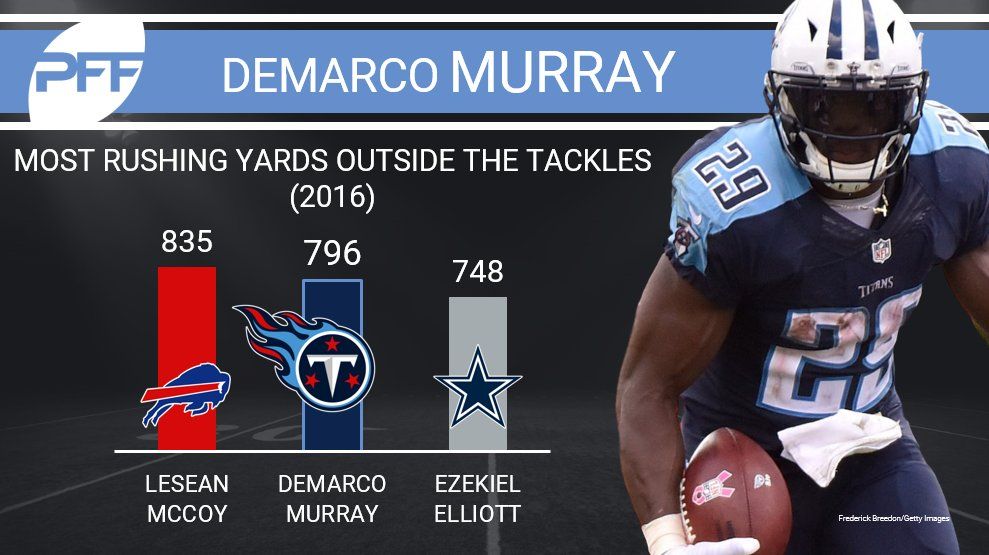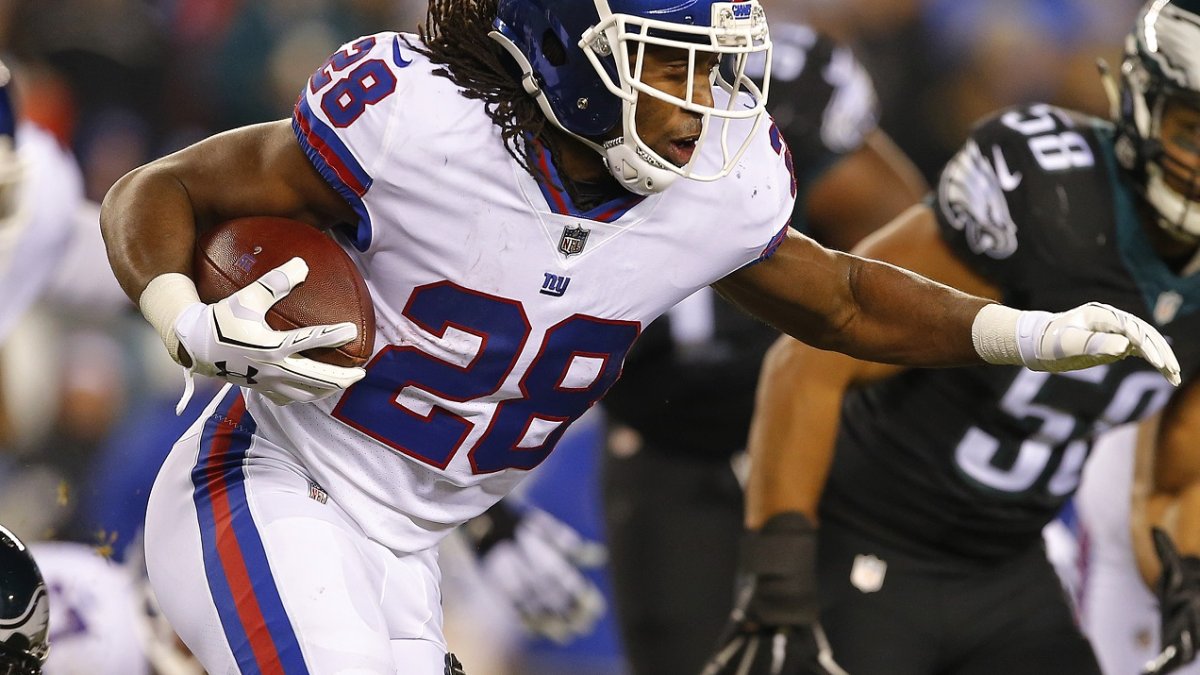Regardless of where you stand on risk aversion, all of us can agree that Identifying which players are the true “upside guys” at various stages of the draft will help you know which players are worth reaching for.
In part one of this series, we examined some upside quarterbacks. This time around let’s turn our attention to your fantasy backfields.
Any running back taken in the first round clearly has a tremendous amount of upside and based off current ADP from FantasyFootballCalculator.com that group includes David Johnson, Le’Veon Bell, Ezekiel Elliott, LeSean McCoy, Melvin Gordon, Devonta Freeman, and Jay Ajayi.
Starting in the second round and on let’s identify the “upside” guys at the position, many of whom come with their share of risk:

DeMarco Murray, Tennessee Titans (ADP: 2.03, RB9)
The presence of Derrick Henry and Murray’s late-season drop in production has scared some away from the Titans’ workhorse. It seems logical. Still, Murray arguably has as much upside as any runner on the board not named Johnson, Bell, or Elliott. The fact that there are five other running backs going ahead of him makes the 29-year-old veteran a nice grab in early Round 2. Henry is likely to see an increased role this year, but Murray is not going away. Tennessee ranked third in rushing a year ago and is loaded up front. Mike Mularkey wants to run the football and Murray will still see the bulk of the workload.
Murray managed to hold on to the job for the duration of the year in 2016 and finished with 1,287 yards and nine touchdowns on 293 carries. He padded his value with his large role in the Titans’ passing game where he caught 53 balls for 377 yards and three touchdowns and finished inside the top-five at the position in pass blocking a year ago.
He’s done well to shake his durability concerns too, as he’s only missed three games over his past four seasons. He’s finished as top-five back twice (RB1 in 2014) in three seasons and inside the top seven fantasy scorers at the position in each of the last four years aside from the his season playing in Philadelphia in Chip Kelly’s offense in 2015. If he holds up and keeps Henry in check, Murray could post elite numbers this season. Either way the floor is pretty high barring injury.
Top-graded pass-blocking RBs:
Jonathan Stewart, 85.3
Robert Turbin, 85.1
Rashad Jennings, 83.5
Latavius Murray, 83.5
DeMarco Murray, 82.4— Pro Football Focus (@PFF) February 10, 2017
Dalvin Cook, Minnesota Vikings (5.04, RB24)
There are several rookie runners who have a chance to put up RB1 numbers in the season ahead, but don’t bet the house on it. They all face position battles and will need to earn their way onto the field. Cook is the one that is currently slipping to Round 5 though. The former Florida State Seminole was one of the most highly regarded running backs coming into the draft, but some didn’t care for his landing spot.
If they knew Cook was going to fall to Round 2 where they could trade up to grab him at such a low cost, the Vikings would have likely never signed Latavius Murray in free agency. A poor combine performance and questions about his off-the-field decisions caused the rookie to fall on draft day. The Murray deal will be easy to break so it wouldn’t come as a surprise if the Vikings decide to pull the plug on the veteran. Cook is a three-down back and the future is coming sooner rather than later in Minnesota.
If he can stay focused and earn the trust of the coaches during training camp and this preseason they won’t be able to keep Cook off the field much. During his college career Cook posted monster numbers while dazzling with his change-of-direction ability. He posted three 1,000-yard seasons during his three years in Tallahassee and had 20 total touchdowns during his sophomore and junior campaigns. His 2017 and dynasty ceiling is as high as any other running back in this year’s draft class.
Paul Perkins, New York Giants (6.02, RB28)
Perkins isn’t a remarkable playmaker by any means, but he does have a tremendous opportunity to have a high workload in 2017 out of the Giants’ backfield. His rookie numbers were unspectacular, but with Rashad Jennings gone, the second-year running back starts training camp as the team’s starter. Veteran Shane Vereen is still in the mix and New York drafted Wayne Gallman in the fourth round this year, but the expectation is Perkins will handle most of the carries.
He only mustered 112 carries in 2016, but did rush for 456 yards. Perkins wasn’t involved much in the passing game and finished with just 15 receptions for 162 yards (67 of those came on one catch). The young running back is still looking for his first career touchdown. When he got an extended look later in the season, there were signs of progression. Perkins closed out his debut season with four straight games with double digit carries, rushing for 271 yards on 62 carries (4.9 YPC) during that span. In his only start of the season in Week 17 he rushed for 102 yards.
There are also reasons to suggest Perkins will see an increased role in the passing game. The offense is complex and as a rookie it took some time for him to learn the system. With a year under his belt Perkins should be ready for more of a role. He did catch 80 balls at UCLA. Despite being on the small side and not all that fast, Perkins is going to be put in a spot in a pretty explosive offense where he could easily match the production of players going a few rounds earlier.
Bilal Powell, New York Jets (6.12, RB32)
Over the last four weeks of 2016, only Le’Veon Bell produced more fantasy points at the position than Powell. He scored three times during that span while rushing 411 yards (5.0 YPC) and pulling in 21 on his 23 targets for an additional 141 yards receiving.
Powell has never scored more the five touchdowns in a season though. Another concern is that the Jets are arguably the worst team in football and definitely boast the league’s most dismal group of quarterbacks. Matt Forte also is still on the team. His presence, coupled with an anemic offense, will limit Powell’s upside. Still, it’s not hard to imagine if things break out that there could be big things ahead. It may very well take an injury to Forte to truly to hit paydirt on Powell.
He has now averaged of 4.0 yards per carry for five straight years and Forte is a shell of his former self. With the departures of Eric Decker and Brandon Marshall, Powell will likely emerge as one of the most reliable targets in the passing game and he’s capable of capitalizing on the opportunity.
Kareem Hunt, Kansas City Chiefs (8.04, RB37)
Kansas City invested a third-round pick on Hunt, and the rookie is expected to battel incumbent Spencer Ware this preseason for the starting job. During his career at Toledo he rushed for 4,945 yards and 45 touchdowns on 782 carries over four seasons despite an injury-riddled junior year. He also caught 73 balls for 555 yards during that span. As a senior, Hunt tallied 1,878 total yards and 11 touchdowns on 303 touches.
The Chiefs traded three picks to move up to grab Hunt, so they clearly covet him. His elusive rating of 112.1 ranked third among all FBS running backs with a minimum of 187 carries. Hunt’s upside no doubt is tied to how well Ware performs. After a fast start last season, in which Ware averaged 5.2 yards per carry over his first six games, the veteran only averaged 3.6 yards per carry the rest of the way and he scored just five touchdowns all year on 247 touches. It’s not hard to imagine Hunt taking over the starting job sooner rather than later.
Deeper dives
C.J. Prosise, Seattle Seahawks (11.03, RB49)
Prosise is continuing to drop down draft boards as the summer rolls along after Seattle signed Eddie Lacy this offseason. He’s arguably still the best playmaker on the entire team though and he should be able to carve out a passing-down role as long as he can stay healthy. If Lacy flops, Prosise could emerge as one of the biggest steals on draft days. Injuries limited Prosise to just six games as a rookie, including fracturing his scapula in Week 11. It was unfortunate timing as just a week earlier he gave us a taste of what he is capable of when he put up 22.3 PPR fantasy points versus the Patriots.
Duke Johnson, Cleveland Browns (12.12, RB53)
There so much buzz right now around Isaiah Crowell, it’s causing Johnson to keep falling down draft boards. He shouldn’t be though. Johnson’s role in the passing game alone puts him squarely on the RB3 radar. He’s averaged 57 catches per season during his first two years as a pro and now there are talks that he’ll emerge as the Browns’ guy in the slot more often than not. His yards per carry also rose in 2016 as he went up from 3.6 YPC as a rookie to 4.9 YPC last season. Playing behind a great offensive line will help him stay efficient with his carries.
Jalen Richard, Oakland Raiders (14.06, RB68)
Before the Raiders pulled Marshawn Lynch out retirement, Richard was a hot commodity in fantasy circles. Now he’s becoming one of the better late-round value grabs. Oakland has one of the league’s best offensive lines and Richard fared well a year after signing as an undrafted rookie out of Southern Mississippi. His 5.9 yards per carry was the best mark of any runner in the league with at least 80 rushing attempts. He also can catch the ball out of the backfield as indicated by the fact he had at least one catch in each of the team’s last 10 contests a year ago. If Beast Mode breaks down, Richard could quickly enter RB2 conversation. Given the fact the 31-year-old was parked on his couch all of last season, it’s not hard to imagine Lynch flaming out.



 © 2024 PFF - all rights reserved.
© 2024 PFF - all rights reserved.